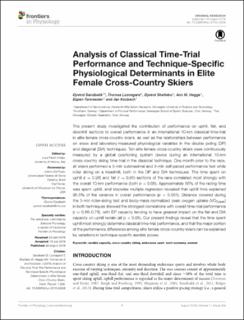| dc.contributor.author | Sandbakk, Øyvind | |
| dc.contributor.author | Losnegard, Thomas | |
| dc.contributor.author | Skattebo, Øyvind | |
| dc.contributor.author | Hegge, Ann Magdalen | |
| dc.contributor.author | Tønnessen, Espen | |
| dc.contributor.author | Kocbach, Jan | |
| dc.date.accessioned | 2020-04-30T13:05:28Z | |
| dc.date.available | 2020-04-30T13:05:28Z | |
| dc.date.created | 2016-10-30T12:10:17Z | |
| dc.date.issued | 2016 | |
| dc.identifier.citation | Frontiers in Physiology. 2016, 7:326 . | en_US |
| dc.identifier.issn | 1664-042X | |
| dc.identifier.uri | https://hdl.handle.net/11250/2653081 | |
| dc.description.abstract | The present study investigated the contribution of performance on uphill, flat, and downhill sections to overall performance in an international 10-km classical time-trial in elite female cross-country skiers, as well as the relationships between performance on snow and laboratory-measured physiological variables in the double poling (DP) and diagonal (DIA) techniques. Ten elite female cross-country skiers were continuously measured by a global positioning system device during an international 10-km cross-country skiing time-trial in the classical technique. One month prior to the race, all skiers performed a 5-min submaximal and 3-min self-paced performance test while roller skiing on a treadmill, both in the DP and DIA techniques. The time spent on uphill (r = 0.98) and flat (r = 0.91) sections of the race correlated most strongly with the overall 10-km performance (both p < 0.05). Approximately 56% of the racing time was spent uphill, and stepwise multiple regression revealed that uphill time explained 95.5% of the variance in overall performance (p < 0.001). Distance covered during the 3-min roller-skiing test and body-mass normalized peak oxygen uptake (VO2peak) in both techniques showed the strongest correlations with overall time-trial performance (r = 0.66–0.78), with DP capacity tending to have greatest impact on the flat and DIA capacity on uphill terrain (all p < 0.05). Our present findings reveal that the time spent uphill most strongly determine classical time-trial performance, and that the major portion of the performance differences among elite female cross-country skiers can be explained by variations in technique-specific aerobic power | en_US |
| dc.language.iso | eng | en_US |
| dc.publisher | Frontiers Media | en_US |
| dc.rights | Navngivelse 4.0 Internasjonal | * |
| dc.rights.uri | http://creativecommons.org/licenses/by/4.0/deed.no | * |
| dc.title | Analysis of classical time-trial performance and technique-specific physiological determinants in elite female cross-country skiers | en_US |
| dc.type | Peer reviewed | en_US |
| dc.type | Journal article | en_US |
| dc.description.version | publishedVersion | en_US |
| dc.source.pagenumber | 9 | en_US |
| dc.source.volume | 7:326 | en_US |
| dc.source.journal | Frontiers in Physiology | en_US |
| dc.identifier.doi | 10.3389/fphys.2016.00326 | |
| dc.identifier.cristin | 1395596 | |
| dc.description.localcode | Copyright © 2016 Sandbakk, Losnegard, Skattebo, Hegge, Tønnessen and Kocbach. This is an open-access article distributed under the terms of the Creative Commons Attribution License (CC BY). The use, distribution or reproduction in other forums is permitted, provided the original author(s) or licensor are credited and that the original publication in this journal is cited, in accordance with accepted academic practice. No use, distribution or reproduction is permitted which does not comply with these terms. | en_US |
| cristin.ispublished | true | |
| cristin.fulltext | original | |
| cristin.qualitycode | 1 | |

